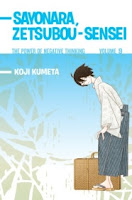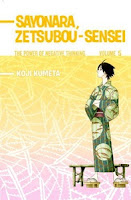My News and Reviews
Last week I posted two in-depth manga reviews here at Experiments in Manga. The first review was for Hiroaki Samura’s Blade of the Immortal, Volume 23: Scarlet Swords. Now that Manji has made his escape from the dungeons under Edō Castle the series has started to focus a bit more on the Ittō-ryū once again, which I’m happy to see. My second review last week was my contribution to the Yun Kouga Manga Moveable Feast. I took a closer look at Viz Media’s new release of Kouga’s Loveless. I had previously read Loveless when Tokyopop published the first eight volumes years ago, but Viz’s first omnibus quickly reminded me why I find the manga so peculiarly compelling.
Last week was also the San Diego Comic-Con. Seeing as it’s clear across the country from me and it’s unlikely that I’d ever be able to handle such a huge event, I wasn’t in attendance. However, I did pay attention to some of the news and announcements coming out of SDCC. I was most interested in Haikasoru’s plans for a graphic novel adaptation of All You Need Is Kill (I reviewed the original a few years ago), a new translation of Battle Royale (I reviewed the previous translation a few years ago, too), and a collection of essays on Battle Royale. In other news: Viz is relaunching the Viz Kids imprint as Perfect Square; Kodansha is adding more shoujo titles to its catalog, including some Del Rey license rescues; and Naoki Urasawa’s 20th Century Boys won its second Eisner Award this year.
Oh! And the next Manga Moveable Feast will soon be upon us! Khursten of Otaku Champloo is hosting August’s Feast early in the month in order to coincide 8/01 (a.k.a. “yaoi day.”) Khursten’s calling it a fujojo fiyaysta and the Feast will be focusing on boys’ love and yaoi. So, join us from August 1 to August 10 for a good time, giveaways, and more!
Quick Takes
 Honeydew Syndrome, Volumes 1-2 by New Shoe. I thoroughly enjoyed Honeydew Syndrome, particularly it’s quirky and true-to-life characters. Initially released as a webcomic, the boys’ love series was later collected in print in two volumes with additional bonus content. The first volume focuses on the somewhat awkward relationship between Metis and Josh which only gets its start after Josh hauls out and punches Metis in the face. The second volume partly overlaps with the first—some of the same events are seen from different perspectives—and focuses on their friends. Honeydew Syndrome doesn’t really have a driving plot; instead, it’s much more about relationships (and not just the romantic ones.)
Honeydew Syndrome, Volumes 1-2 by New Shoe. I thoroughly enjoyed Honeydew Syndrome, particularly it’s quirky and true-to-life characters. Initially released as a webcomic, the boys’ love series was later collected in print in two volumes with additional bonus content. The first volume focuses on the somewhat awkward relationship between Metis and Josh which only gets its start after Josh hauls out and punches Metis in the face. The second volume partly overlaps with the first—some of the same events are seen from different perspectives—and focuses on their friends. Honeydew Syndrome doesn’t really have a driving plot; instead, it’s much more about relationships (and not just the romantic ones.)
 Saiyuki Reload, Volumes 1-3 by Kazuya Minekura. Though the manga changed names, magazines, and demographics, Saiyuki Reload is a direct followup to Minekura’s Saiyuki. While I enjoyed the slightly ridiculous Saiyuki, for some reason Saiyuki Reload doesn’t seem to be clicking as well with me. Despite a few flashbacks delving into Sanzo’s past, these early volumes just don’t feel like they’re going anywhere with either the story or the characters. It’s as if Sanzo and his crew are simply playing their previously established roles; the character development seems to be missing. However, the artwork in Saiyuki Reload is more polished than that in Saiyuki. (It is a more recent series after all.) The action sequences tend to be clearer and easier to follow, too.
Saiyuki Reload, Volumes 1-3 by Kazuya Minekura. Though the manga changed names, magazines, and demographics, Saiyuki Reload is a direct followup to Minekura’s Saiyuki. While I enjoyed the slightly ridiculous Saiyuki, for some reason Saiyuki Reload doesn’t seem to be clicking as well with me. Despite a few flashbacks delving into Sanzo’s past, these early volumes just don’t feel like they’re going anywhere with either the story or the characters. It’s as if Sanzo and his crew are simply playing their previously established roles; the character development seems to be missing. However, the artwork in Saiyuki Reload is more polished than that in Saiyuki. (It is a more recent series after all.) The action sequences tend to be clearer and easier to follow, too.
 Sayonara, Zetsubou-Sensei: The Power of Negative Thinking, Volumes 9-10 by Koji Kumeta. Sayonara, Zetsubou-Sensei was originally released in English by Del Rey, but it is one of the series that Kodansha now continues to publish. It’s a slow seller—there hasn’t been a volume released in over a year—but I can understand why. The series tends to be episodic, has a very specific sense of humor, and the sheer number of cultural references it uses makes the series challenging to translate and adapt. Despite the fact that I often find Sayonara, Zetsubou-Sensei to be hilarious in a darkly absurd way, I can only read a volume or two at a time without it feeling like a chore. But I do like the series and am glad that it’s available.
Sayonara, Zetsubou-Sensei: The Power of Negative Thinking, Volumes 9-10 by Koji Kumeta. Sayonara, Zetsubou-Sensei was originally released in English by Del Rey, but it is one of the series that Kodansha now continues to publish. It’s a slow seller—there hasn’t been a volume released in over a year—but I can understand why. The series tends to be episodic, has a very specific sense of humor, and the sheer number of cultural references it uses makes the series challenging to translate and adapt. Despite the fact that I often find Sayonara, Zetsubou-Sensei to be hilarious in a darkly absurd way, I can only read a volume or two at a time without it feeling like a chore. But I do like the series and am glad that it’s available.
 Here Is Greenwood directed by Tomomi Mochizuki. Based on the shoujo manga series by Yukie Nasu, Here Is Greenwood is a six-episode OVA. Although it is a mix of strict adaptation, new material, and slight re-imaginings of the stories in the original, the anime stays very true to the tone of the manga. I read and enjoyed Here Is Greenwood and I enjoyed the anime as well, but I don’t think that it will hold much appeal to those who aren’t already familiar with the characters. Here Is Greenwood is fairly episodic but the stories all revolve around the perpetually stressed-out high school student Kazuya Hasukawa, his oddball dorm and class mates, and the often absurd situations they find themselves in. The series is quirky and funny and made me laugh on several occasions.
Here Is Greenwood directed by Tomomi Mochizuki. Based on the shoujo manga series by Yukie Nasu, Here Is Greenwood is a six-episode OVA. Although it is a mix of strict adaptation, new material, and slight re-imaginings of the stories in the original, the anime stays very true to the tone of the manga. I read and enjoyed Here Is Greenwood and I enjoyed the anime as well, but I don’t think that it will hold much appeal to those who aren’t already familiar with the characters. Here Is Greenwood is fairly episodic but the stories all revolve around the perpetually stressed-out high school student Kazuya Hasukawa, his oddball dorm and class mates, and the often absurd situations they find themselves in. The series is quirky and funny and made me laugh on several occasions.






